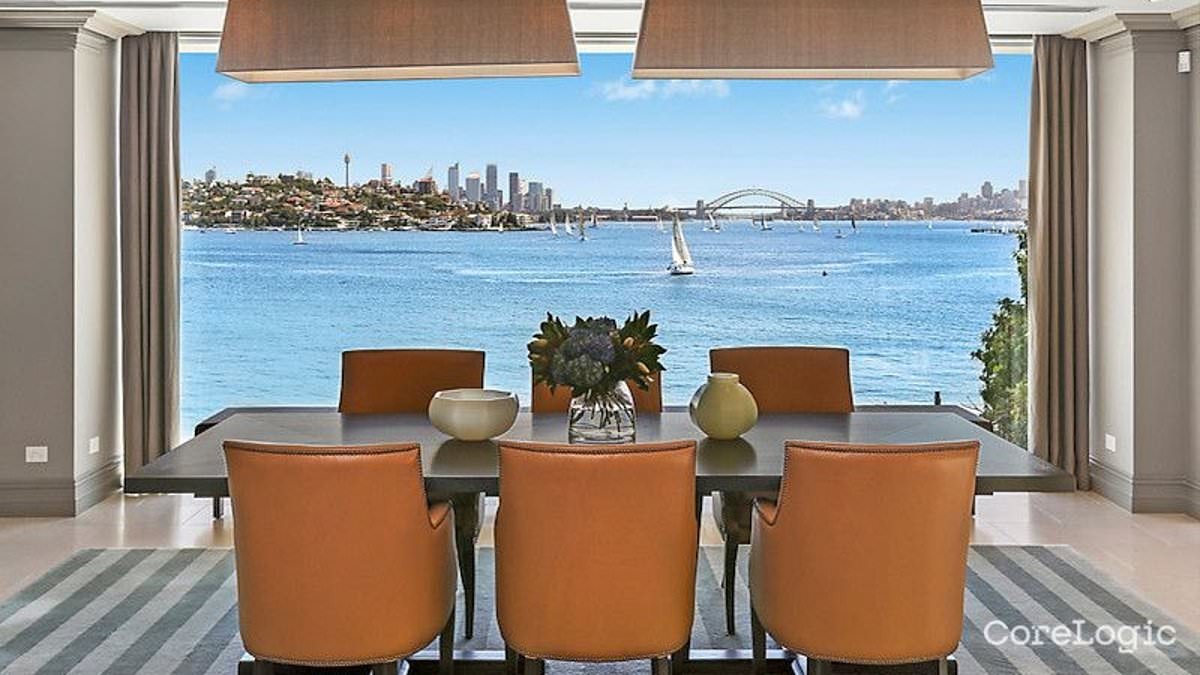A multi-millionaire neighbour in one of Sydney’s most wealthy suburbs has been dealt a bitter blow after losing a costly court claim that six palm trees ruined the view from her $27million harbourside mansion.
Barrister Georgina Black and her husband, a property executive, live in the trophy home ‘Indah’ which has spectacular views of the Sydney Opera House.
But she has just lost out after being beaten in her court appeal by Samira Jeihooni, the wife of property developer Arash Tavakoli.
The Rose Bay neighbours had faced off after Ms Black complained that Ms Jeihooni had planted six cabbage palms on her nearby property in November 2021.
Ms Black and husband Graham Edwards, chief of UK property giant Telereal Trillium, had bought their five-bedroom mansion with uninterrupted views of Sydney Harbour in 2015.

Samira Jeihooni, the wife of property developer Arash Tavakoli, won the court battle

Barrister Georgina Black and her husband, a property executive, live in the trophy home ‘Indah’ which has spectacular interrupted views (above) of Sydney Harbour
Ms Black asked the Land and Environment Court to order Ms Jeihooni to remove the cabbage palms, which can grow up to 15m high.
She said the palms were obstructing her views of the Harbour Bridge and Opera House from her dining room, kitchen and a first-floor bedroom.
Ms Black insisted that Ms Jeihooni should plant a different type of tree which would grow to no more than than 8m.
Her town planner said in her application that four of her neighbour’s the palms had a ‘severe and devastating impact’ on her views.
But Ms Jeihooni said the trees helped give privacy and provided shade to her garden, swimming pool and house.
Last year, the Land and Environment Court decided against Ms Black, ruling that the palms did not significantly obstruct her view and that since the the application was made, Ms Jeihooni had the trees pruned.
Ms Black appealed against the ruling but it was dismissed, and she has been ordered to pay costs.
The ruling by Justice Nicola Pain came after both sides engaged senior barristers to fight one another in the appeals hearing.

Georgina Black, a barrister who owns the mansion with her property executive husband, has just lost a costly appeal to have the six palm trees chopped down

Before the trees (above, plan of property submitted to Land and Environment Court) were planted, Georgina Black claimed she had spectacular views of the Harbour Bridge and Opera House from her dining room, kitchen and a first-floor bedroom
Justice Pain found there had been ‘no error of law in the determination that four palm trees did not form a hedge’.
The decision is a bitter blow for Ms Black, who is known as a feisty legal practitioner in her field, and whose purchase of the magnificent waterfront mansion nine years ago was painted as a ‘triumphant return home’ from the UK for the former Sydney private schoolgirl.
During the lengthy court battle over Ms Black’s view, acting Land and Environment commissioner, Lynne Sheridan said that Ms Black’s husband had offered to pay for the removal of the palms.
But that was turned down by Ms Jeihooni’s husband, with Ms Sheridan noting that ‘the nature of communications between the parties during the hearing satisfied me that they would be unlikely to reach agreement’.
In order to make the Jeihoonis cut down their palms, the court had to find that two or more of the trees formed a hedge and severely obstructed a view.

Pictured: The view of Sydney Harbour from a bedroom at Ms Black’s home in Rose Bay
While Ms Black’s arborist said the cabbage palms did form a hedge, Ms Jeihooni’s arborist said they didn’t and never would as their leaves can’t connect.
Ms Sheridan, who visited the site, found the palms did not form a hedge, giving three reasons in her explanation.
Firstly, she said the trees were not planted close enough together to form a continuous barrier or screen.
‘Secondly, I find it unlikely that someone attempting to establish a hedge or screen would have planted palm trees which characteristically have a straight slender trunk with fronds at the top of the trunk,’ Ms Sheridan said.
‘Thirdly, there is no sign that these trees have ever been maintained by (Ms Jeihooni) as a hedge.’

Six palm trees caused a costly courtroom battle over $27million harbourside views (pictured) in Rose Bay, one of ‘s wealthiest suburbs

Ms Black asked the Land and Environment Court to order Ms Jeihooni to remove the cabbage tree palms, which can grow up to 15 metres (stock image)
Ms Sheridan added that the trees obstructed little of Ms Black’s views.
‘For example, my observations on site were that the palms do obstruct views of the Harbour and the Sydney Harbour Bridge from several seats at the dining room table or from one particular view from the kitchen.
‘However the totality of the view, including views of Sydney Harbour, the Harbour Bridge and Opera House from other parts of the dining room table, dining room, living room, kitchen, secondary living areas and bedrooms are retained,’ she said.
